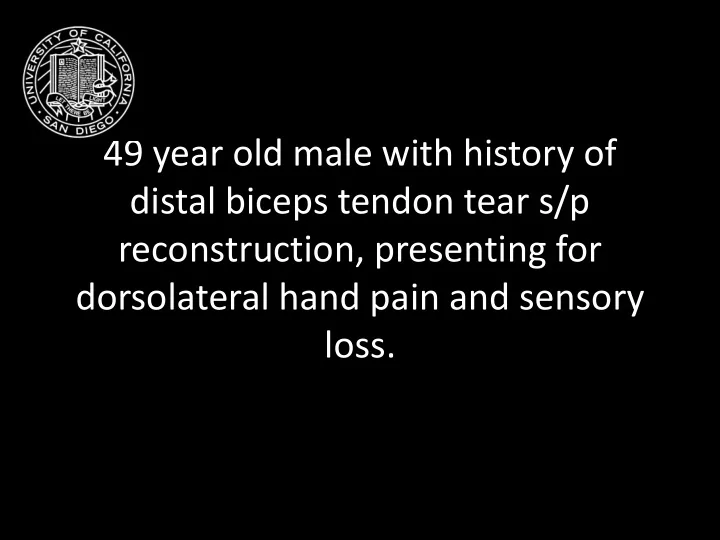

49 year old male with history of distal biceps tendon tear s/p reconstruction, presenting for dorsolateral hand pain and sensory loss.
STOP
Wartenberg's Syndrome* • Compressive neuropathy of the superficial sensory radial nerve *Atypical Case
Anatomy Radial Nerve At the level of the radiohumeral joint line, the radial nerve divides into its terminal branches: • Superficial branch • Deep branch PIN * * PIN after it penetrates the supinator muscle http://image.slidesharecdn.com/1nervesofupperextremity-160518155137/95/1-nerves-of-upper-extremity-85-638.jpg?cb=1463586743
Anatomy Radial Nerve At the level of the radiohumeral joint line, the radial nerve divides into its terminal branches: • Superficial branch • Deep branch PIN * * PIN after it penetrates the supinator muscle Linda D, Harish S, Stewart B, Finlay K. Multimodality Imaging of Peripheral Neuropathies of the Upper Limb and Brachial Plexus 1. Radiographics .
Anatomy Superficial Branch of Radial Nerve Medial branch • sensory function to the ulnar half of the dorsal thumb, dorsal index, long, and radial half of the ring finger Lateral branch • sensory function to the radial dorsal thumb Gray's Anatomy, Plate 812, Wikipedia
Anatomy Superficial Branch of Radial Nerve Medial branch • sensory function to the ulnar half of the dorsal thumb, dorsal index, long, and radial half of the ring finger Lateral branch • sensory function to the radial dorsal thumb Gray's Anatomy, Plate 812, Wikipedia
Anatomy Superficial Branch of Radial Nerve Medial branch • sensory function to the ulnar half of the dorsal thumb, dorsal index, long, and radial half of the ring finger Lateral branch • sensory function to the radial dorsal thumb http://www.orthobullets.com/anatomy/10105/superficial-radial-nerve
Common Entrapment Neuropathies at the Elbow Radial Nerve and Posterior Interosseous Nerve • Entrapment at the radiocapitellar joint – radial tunnel, the leash of Henry, or the arcade of Frohse. Median Nerve and Anterior Interosseous Nerve • Entrapment at a supracondylar spur and Struthers ligament, the bicipital aponeurosis, the area between the humeral and ulnar heads of the pronator teres muscle, or the fibrous arch of the flexor digitorum superficialis muscle. Ulnar Nerve • Entrapment at the arcade of Struthers, the medial intermuscular septum, the cubital tunnel, the area between the two heads of the FCU, or the flexor pronator aponeurosis. Not Superficial Branch of Radial Nerve
Entrapment Neuropathies at the Elbow PIN Compression Syndrome • Typically involves the deep branch of the radial nerve as it becomes the PIN • 5 typical locations – fibrous tissue anterior to the radiocapitellar joint – “leash of Henry” – extensor carpi radialis brevis edge – "arcade of Fröhse" – supinator muscle edge http://www.orthobullets.com/hand/6023/pin-compression-syndrome
Wartenberg's Syndrome • Compressive neuropathy of the superficial sensory radial nerve (SRN), also called "cheiralgia paresthetica “ • Characterized by sensory manifestation only with no motor deficits • Parasthesias and numbness in the dorsoradial hand http://www.orthobullets.com/hand/6025/wartenbergs-syndrome
Wartenberg's Syndrome • Compressive neuropathy of the superficial sensory radial nerve (SRN), also called "cheiralgia paresthetica “ • Characterized by sensory manifestation only with no motor deficits • Parasthesias and numbness in the dorsoradial hand Linda D, Harish S, Stewart B, Finlay K. Multimodality Imaging of Peripheral Neuropathies of the Upper Limb and Brachial Plexus 1. Radiographics .
Typical Wartenberg's Syndrome Causes • May result from trauma or extrinsic compression in the forearm/wrist. • SRN may be compressed by scissoring action of brachioradialis and ECRL tendons during forearm pronation, or by fascial bands at its exit site in the subcutaneous plane Associated with De Quervain's disease in 20-50%, often the primary differential diagnosis Prognosis – Spontaneous resolution of symptoms is common – 74% success after surgical decompression ####
EMG Report: 8/26/2016 Summary: • Right radial nerve sensory response is absent. Right lateral and medial antebrachial, median, and ulnar nerve sensory responses are normal except for mild reduced amplitude in ulnar nerve. • Right median, ulnar, and radial (EIP) nerve motor responses are normal. Conclusion: • This is an abnormal study. There is evidence of a right radial superficial sensory neuropathy . There is no evidence of a lateral antebrachial cutaneous neuropathy. There is no definite evidence of other radial nerve involvement, cervical motor radiculopathy, brachial plexopathy, or large fiber polyneuropathy.
References 1. Woon, Colin. "Wartenberg's Syndrome." Orthobullets . Web. 13 Oct. 2016. 2. Linda D, Harish S, Stewart B, Finlay K. Multimodality Imaging of Peripheral Neuropathies of the Upper Limb and Brachial Plexus. Radiographics . 2010;6:1373-1400. doi:10.1148/rg.305095169/-/DC1. 3. Stadnick, Michael. "Posterior Interosseous Nerve Syndrome." Radsource ., 2014. Web. 13 Oct. 2016. 4. Watts, Evan. "PIN Compression Syndrome." Orthobullets . Web. 13 Oct. 2016.
Recommend
More recommend